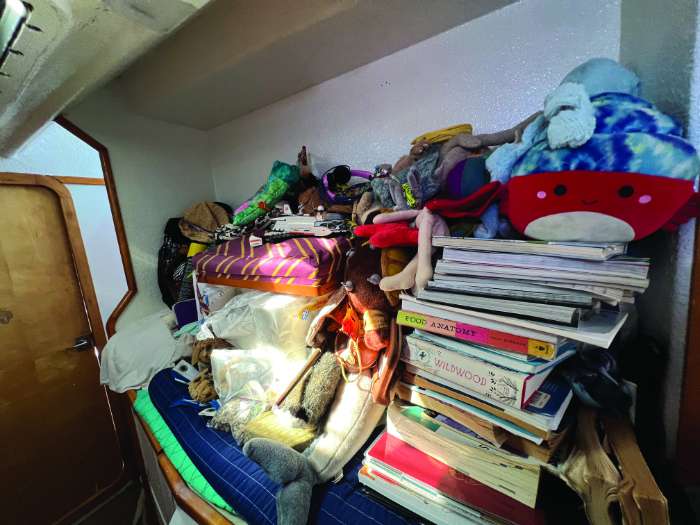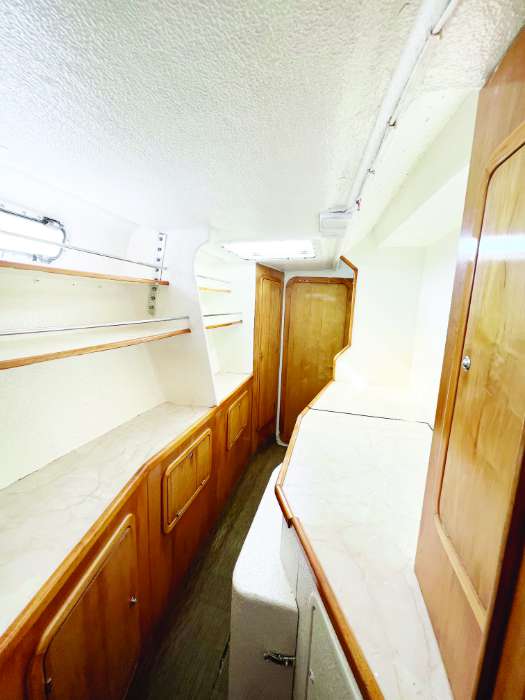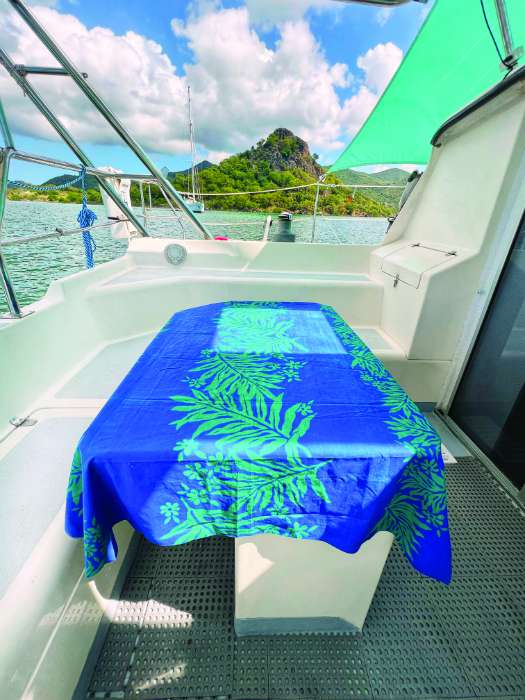Purging, Cataloging, Getting Rid of Quirks: Steps To Prepare Your Sailboat for a Sale
It was daunting to be anchored on our cruising catamaran with everything we own in the whole world inside and needing it to sell. Even if you don’t live aboard, when it’s time to say goodbye to your boat and create the listing, it can be more work than you think. As long time liveaboards and cruisers, it took us a solid month to get it done.
 Photographs
Photographs
I would argue that this is the single most important thing needed to sell a boat. It makes me cringe to look at listings and see rumpled beds, piles of shoes, personal belongings everywhere, and even dirty heads. Ick.
Every time we had to stage and photograph a section of the boat, we emptied that section completely. We emptied it of 20 years of life well lived. Sweating in the Caribbean heat, I went back and forth and back and forth with piles of stuff. Then, we had to scrub, paint, touch up, and stage. Things we lived with day to day now stood out like a neon sign. I’m dirty! My hinge is loose! Varnish me! Your throw pillows are tacky!
So, we did the work. We cleaned and cleared, and we took the time to make the space just right. I held my breath for the perfect photos. Of course, emptying a cabin meant piling all of the contents of that cabin into another part of the boat. Precarious piles of stuff were behind me while a pristine, staged section of the boat opened in front of me for photographs.
 Time to purge
Time to purge
Nobody wants to buy a boat with all of your stuff on it. Spare parts? Yes. Knick knacks, old books, and your chipped dishes? No.
Before we put our life back into the cabin we had just staged for photos, we had to sort the stuff we pulled out. Why do we still have this? This thing is full of mildew. Our kids outgrew these toys or clothes years ago.
As we sorted, new piles began to form. There was a pile for donation. There was another pile of things to pass along to other boaters. There was the pile for the dump. I said a mea culpa to the environment as we took five to seven huge bags a day to the dumpsters in Sint Maarten. I eased my guilt by telling myself we’ve been living so gently on the planet the last 26 years, so a little extra garbage was okay.
We decided to take it a step further by putting in brand new heads and plumbing the day we moved off the boat to give the next owners a fresh start.
Catalog your boat
Now it’s time to put the stuff that made the cut back in the newly detailed part of the boat. This is the time to also start your lists. Depending on what your plans are after the sale of your boat, you have to decide what stays with the boat and what moves off with you when you depart the boat for the last time. The items that stay need to get cataloged for the listing specs. Those fans over your bunk: what brand are they? That storage locker: what are the interior dimensions? That new mattress you splurged on last year: how thick is it and what is it made out of?
Even if all of these details do not make it into your specs, believe me, some prospective buyer will come along and ask for the most random detail. It’s best to have an answer rather than have them possibly lose interest.
While you catalog and sort, don’t forget your boat papers. Find those receipts, owner’s manuals, and warranties. If you don’t already have them organized, put them into a binder of some sort for the next owner. It’s a good idea to scan each one and keep a copy for yourself. If your boat will sit somewhere for sale and you don’t live nearby, you will kick yourself when your broker or a prospective buyer asks for information in the binder, and you don’t have a digital copy on hand.
 Eliminate quirks
Eliminate quirks
If you sail your boat often, you will have some little quirky jury rig somewhere on your boat. Maybe your button latch has a Lego on it because the button fell off long ago? Maybe you let your teenager put stickers all over his door, and now it’s full of teen angst and sass. Maybe these examples are too personal?
This is the time to take the personal touches out of the boat, even if it means days of scraping sticker residue from a wood door and sanding and varnishing it back to life. Adios Lego. We finally special ordered that button latch and put it back on. And while my family loved the psychedelic rainbow wheel cover, we removed it and made one that matched the canvas.

Details matter
Show as much detail as possible, not only to highlight what’s special about your boat, but to show a potential buyer that you have nothing to hide. Photograph the engine, show the inside of the fridge, get some close-up beauty shots of your windlass, winches, anchor, and running rigging. Does your boat have special lighting? Take some night photos to show that off. Don’t forget out-of-the-water photos, too. If you haul her for sale or do one last bottom job before leaving the boat, get pics of the freshly painted bottom, her rudder, propellers, and the shape of the hull.
Cruisers are part of a happy, salty cult, so you should look for opportunities to take photos that reflect that. If you have a drone, get those shots from above while at anchor or underway. If you cruise somewhere gorgeous, take the dinghy and circle the boat from afar to show her anchored in that beautiful spot. If you’re trimmed perfectly headed downwind, snap some pics of that spinnaker pulling you along.
You’re not just selling a boat; you’re selling a lifestyle and a dream. One word of warning though, doing all of these things just may make you think twice about selling your boat.
About the Author: For three years, Annapolis sailor Cindy Wallach cruised the Caribbean with her family aboard their St. Francis 44 MK II catamaran Majestic, which is now for sale through multihullcompany.com.
Find more cruising articles.




